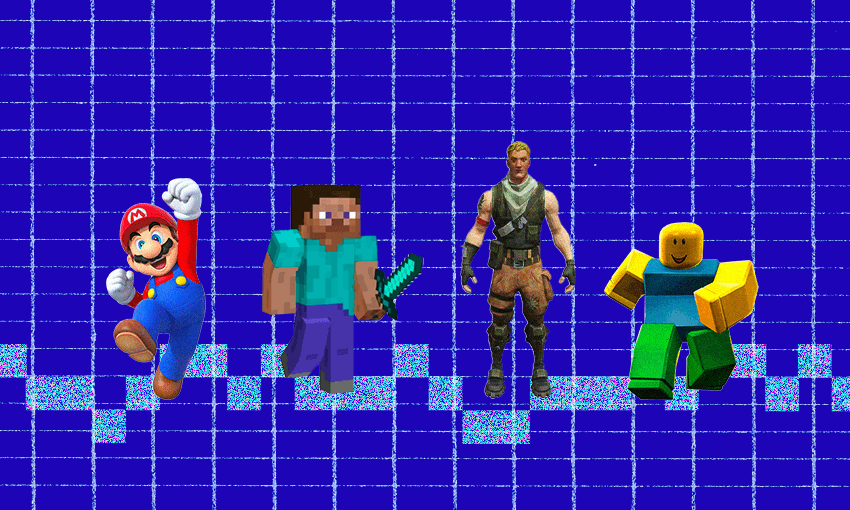Despite decades of mega revenue, gaming remains massively undervalued.
Think about the combined cultural power of the music and film industries – the way they reflect and guide the social mores of contemporary life, how these two dominant art forms fill the crevices of our lives, the content of our small talk, the hours of our evenings. Then think about the sort of money that kind of ubiquity generates. Yet combine the worth of those two industries, and it is still less than what gaming generates.
“The game industry globally,” says Chelsea Rapp, Chairperson of the New Zealand Game Developers Association (NZDGA), “is in terms of revenue worth more than global film and global music combined.”
It is, she says, an industry that New Zealand investors are only just starting to discover. “The rest of the world has made incredible investment in this space, and has opened up spaces for small daily investors to get involved. Here in Aotearoa we’re only really starting to see the first equity investments in games in the last two years. But I think that’s only going to continue to grow.”
Gaming, she notes, is so much bigger than what might come instantly to mind – sitting down in front of an Xbox or Playstation or PC. Four out of five New Zealanders, she says, describe themselves as gamers. And some of the remainders just might not realise that they too fit within that category. “It’s also all of these incredible applications of game technology,” Rapp says, “and the gamification of everything, from education to fitness to medical rehab training, job simulations – really the kind of whole spread of opportunities for the sector.”
Gaming, says Megan Stals, a market analyst with Stake, is “far from the stereotypical images of teenage boys – almost everyone has played some kind of game on a mobile phone”. That growing dominance, Stals says, means that the gaming sector enables wider opportunities for investment than the likes of the well-known game developers and the big hardware suppliers – Microsoft (NASDAQ:MSFT), Nintendo (OTC:NTDOY), Sony (NYSE:SONY). As the sophistication of gaming continues to improve, it will drive, too, the growth of the technology required to supply it: semiconductor firms, datacentres, cloud-based technology. As WIRED puts it, the future of gaming is being powered by an “infrastructure arms race”.
It is a future that is also being consolidated by the rise and rise of esports – the finals of 2021’s Free Fire World Series attracted a record-breaking 5.4 million views – and the crossover success of series like HBO’s massive hit The Last of Us, which began life as a much-awarded video game.
Similarly, emergent technologies like augmented and virtual reality found their initial impetus in the video game sector, says Rapp. And these days, she says, you are starting to see “greater application of those technologies in non-game spaces”. Recently, Unity, one of the most common game engines, became for the first time more widely used for industrial purposes than it was to power games themselves. “There’s an incredible expansion of businesses who are looking to these technologies – augmented reality, virtual reality, game engines, game tech – to expand their business opportunities and look for new business verticals,” Rapp says.
It means that what Rapp calls “adjacent businesses” are starting to realise the benefits of gaming, and the technology it both requires and enables. When we spoke, the NZGDA had recently concluded its 2023 conference. Typically, she says, 500-600 people would come through the doors; this year there were over 1,000, in what she calls “incredible growth” for the conference itself. She forecasts similar growth for the New Zealand games industry at large, especially on the back of recent government initiatives like the $40 million put towards the Game Development Sector Rebate in the Government’s 2023 Budget.
“I love to compare it to Finland,” she says of the state of the industry in Aotearoa, and how big it could grow, “because Finland is about the same size as New Zealand, both geographically and in population, and their games industry is worth about $5 billion annually. We’re at about $400 million.” She suspects, she says, “that we are going to see a lot more investment in this space”.
The NZGDA also runs an annual investment event – at last year’s, in Auckland, more than 200 people attended, everyone from “really well-established investment firms to smaller everyday investors”. Stals says it “could be a good time” to join them, in a market that flourished during the height of the pandemic and is now rebounding from a sluggish 2022. For Rapp, the industry at large differs from its tech-sector cousins in that it doesn’t rely on “these entrepreneur personalities that are sort of evangelists for their product”.
There’s also an agility to the market that comes with almost all of us having the requisite hardware in our pockets at all times: our phones. Accordingly, mobile gaming, says Stals, is the most lucrative sub-sector within the industry. As Rapp says, “in games, you more often have people who just started as programmers, or designers, or artists, and had an idea that just really connected with their user base. And so you’re seeing small teams of four and five, making millions of dollars a year, having very little experience in business or scale or any of the things that you would typically associate with investment.”
When considering where to invest, Stals says, the well-known publishers of the big-budget, high-profile games can be a safe bet, but consider whether a publisher is too reliant on a single title; and that demand for hardware is potentially a more stable market than companies that rely on a churn of new releases for the majority of their revenue. The sector, she also notes, can suffer at the hands of regulators, with governments concerned about the amount of time young people are spending in front of screens.
For Rapp, the future of gaming lies in “user-generated content”, games in which the players themselves can have a hand in crafting the worlds in which they play – games and spaces like Unreal Engine, Roblox (NYSE:RBLX) and Minecraft – and which afford opportunities for networking and social gaming. “Ultimately,” she says, “the internet makes us more and more connected every day. It’s never gone the other direction. And so companies and businesses that are creating tools to support that future, I think, have the greatest opportunity.”
As Stals says, the market can only grow as digital natives – those for whom socialising within Minecraft, say, is as commonplace as doing so on the playground – grow into adulthood. And for that generation, Rapp says, gaming already has the cultural centrality that older artforms do for older generations. “This is what they grew up with, right? It’s been ubiquitous since the day they were born. And so it’s become a part of their cultural zeitgeist and their cultural identity. And they’re looking at it as not just a form of cultural expression, but as a way to express themselves as individuals.”
Investing in that future only makes sense, Rapp says. “There’s really never been a better time to get into this space. And I’m certainly encouraging everyone… to really start to expand their repertoire of knowledge to include game business models, because I think we’re going to see more and more businesses that want to get into this space.”

